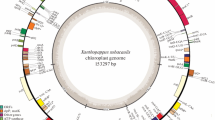Abstract
The chloroplast genome sequence of an endangered relict tree species endemic to China, Emmenopterys henryi, was determined based on the Illumina data. The chloroplast genome of E. henryis was sequenced (155,379 in length, GenBank accession number KY273445). It contains 62.36% A+T base pairs and consists of a pair of inverted repeats (IRs, 25,790 bp) separated by the large single-copy (LSC, 85,554 bp) and small single-copy (SSC, 18,245 bp) regions. The chloroplast genome contains 132 unique genes, including 87 protein-coding genes, 37 transfer RNA genes and 8 ribosomal RNA genes, respectively. The phylogenetic analysis based on chloroplast genomes indicates that E. Henryi is most closely related to coffea arabica and coffea canephora.
Similar content being viewed by others
Avoid common mistakes on your manuscript.
Emmenopterys henryi (Rubiaceae), a native species to China, is a Tertiary relict deciduous tree species and it is the only extant species in its genus (Emmenopterys), but fossils of the genus from the Eocene are found in North America and Germany (Manchester et al. 2009). The species is known to be distributed only in disjunct montane valleys at elevations ranging between 400 and 2000 m above sea level of temperate deciduous forests scattered across subtropical China (Zhang et al. 2016). Because of the small number of populations, a low ability of seed germination, a low rate of natural regeneration and fragment environment, E. henryi is listed as the near threatened (NT) species according to the China Species Red List (Wang and Xie 2004). Understanding the chloroplast genome information of this rare and endangered tree may provide valuable guidelines for the development of management strategies for both in situ and ex situ conservation activities. In this study, we have mapped and determined the complete chloroplast genome sequence of E. henryi based on the Illumina data.
Young and healthy leaf samples of E. henryi were sampled for DNA isolation with the DNeasy Plant Mini Kit (QIAGEN, German) from Yaoluoping National Nature Reserve, Anhui Province, China. The whole-genomic DNA data was sequenced using the Illumina Hiseq 2500 platform. We assembled the complete cp genome with MITObim, version 1.8 with that of the Coffea arabica (EF044213) (Samson et al. 2007) as the reference. The cp genome was annotated with GENEIOUS R10 (Biomatters Ltd., Auckland, New Zealand) using default parameters to predict the protein-coding genes, transferRNA (tRNA) genes, and ribosome RNA (rRNA) genes. The complete cp genome sequence was submitted to the GenBank to get the accession number KY273445 (Fig. 1).
Physical map of the Emmenopterys henryi chloroplast genome. Genes shown outside the outer circle are transcribed in the clockwise direction, whereas those inside are transcribed in the counterclockwise direction. Areas dashed darker and light gray in the inner circle indicates the G+C and A+T contents of the genome, respectively
The length of the complete cp genome is 155,379. The cp genome consists of a pair of inverted repeat (IRa and IRb) regions of 25,790 bp, small single copy (SSC) and large single copy (LSC) regions with the lengths of 18,245 and 85,554 bp, respectively (Fig. 1). The cpDNA of E. henryi encodes an identical set of 132 unique genes, including 87 protein coding, 8 ribosomal RNA genes, and 37 transfer RNA, respectively. The AT content of the whole cpDNA of E. Henryi is 62.36%, while the corresponding values of the SSC, LSC, IR regions are 68.10, 64.51 and 56.74% respectively. To identify the phylogenetic position of E. henryi, a neighbor-joining (NJ) tree using MEGA 6.0 program (Tamura et al. 2013) was performed based on the 87 protein-coding genes from 18 Gentianales plant taxa (4 Rubiaceaes, 10 Apocynaceaes and 5 Gentianaceaes). The result has shown that the cp genome of E. henryi is closely related to that of Coffea arabica and Coffea canephora (Fig. 2).
Phylogenetic trees from the analyses of the nucleotide substitutions of the completely sequenced chloroplast genomes in 18 cpDNA taxa. Phylogenetic relationships of 18 species within the order Gentianales based on the NJ of the concatenated coding sequences of 87 chloroplast PCGs. The bootstrap values were based on 100 replicates, and are shown next to the branches
References
Manchester SR, Chen ZD, Lu AM, Uemura K (2009) Eastern Asian endemic seed plant genera and their paleogeographic history throughout the Northern Hemisphere. J Syst Evol 47:1–42
Samson N, Bausher MG, Lee SB, Jansen RK, Daniell H (2007) The complete nucleotide sequence of the coffee (Coffea arabica L.) chloroplast genome: organization and implications for biotechnology and phylogenetic relationships amongst angiosperms. Plant Biotechnol J 5:339–353
Tamura K, Stecher G, Peterson D, Filipski A, Kumar S (2013) MEGA6: molecular evolutionary genetics analysis version 6.0. Mol Biol Evol 30:2725–2729
Wang S, Xie Y (2004) China species red list. Higher Education Press, Beijing
Zhang YH, Wang IJ, Comes HP, Hua P, Qiu YX. (2016). Contributions of historical and contemporary geographic and environmental factors to phylogeographic structure in a tertiary relict species. Emmenopterys henryi (Rubiaceae). Sci Rep. doi:10.1038/srep24041
Acknowledgements
This work was supported by Grants from the National Natural Science Foundation of China (31570417), Anhui Provincial National Science Foundation (1608085MC63) and Anhui Provincial Key Project of Higher Education Institutions for Excellent Visiting Scholar (gxfxZD 2016172).
Author information
Authors and Affiliations
Corresponding author
Rights and permissions
About this article
Cite this article
Duan, Ry., Huang, My., Yang, Lm. et al. Characterization of the complete chloroplast genome of Emmenopterys henryi (Gentianales: Rubiaceae), an endangered relict tree species endemic to China. Conservation Genet Resour 9, 459–461 (2017). https://doi.org/10.1007/s12686-016-0681-1
Received:
Accepted:
Published:
Issue Date:
DOI: https://doi.org/10.1007/s12686-016-0681-1






